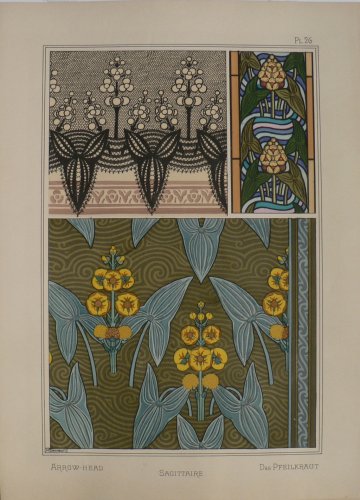Grasset, Eugene. Saggittaire. La Plante, 1898. $300.00

(Arrowhead) Plate 26
Eugene Grasset (1845-1917) was an influential figure in the development of the Art Nouveau movement in art, architecture and decorative arts. He was born in Switzerland to a cabinet designer/maker and sculptor, he studied drawing under Francois-Louis David Bocion and architecture in Zurich. His work was inspired by his travels to Egypt and his admiration of Japanese art. His had extensive experience in a wide variety of fine and decorative arts - working as a painter and sculptor in Lausanne, designing furniture fabrics, tapestries, ceramics and jewelry before turning to graphic design and poster art. French posters were becoming increasingly popular in the United States at the time and he was soon employed by American companies including Harper's Magazine and The Century Magazine..
Art Nouveau was inspired by natural forms. It was a style popular at the turn of the twentieth century that was intended to be applied to architecture, graphic art, interior design, furniture, textures, lighting and fine art.
The fabulously decorative prints from La Plante et ses Applications Ornamentales are a fine example of the totality of the Art Nouveau vision. The plates were created as a series of three, each devoted to the depiction of a single flower as it might be used in wallpaper and tile designs, pottery, furniture, book covers, stained glass, etc.
At the Universal Exhibition of 1900 in Paris, the G. Peignot et Fils typefoundry, introduced the "Grasset" typeface, an Italic design Eugène Grasset created in 1898 for use on some of his posters.
Pochoir technique of hand coloring over stencils.
17 ¾ inches x 12 ¾ inches, sheet.
Excellent condition.
or click to inquire about this print.
